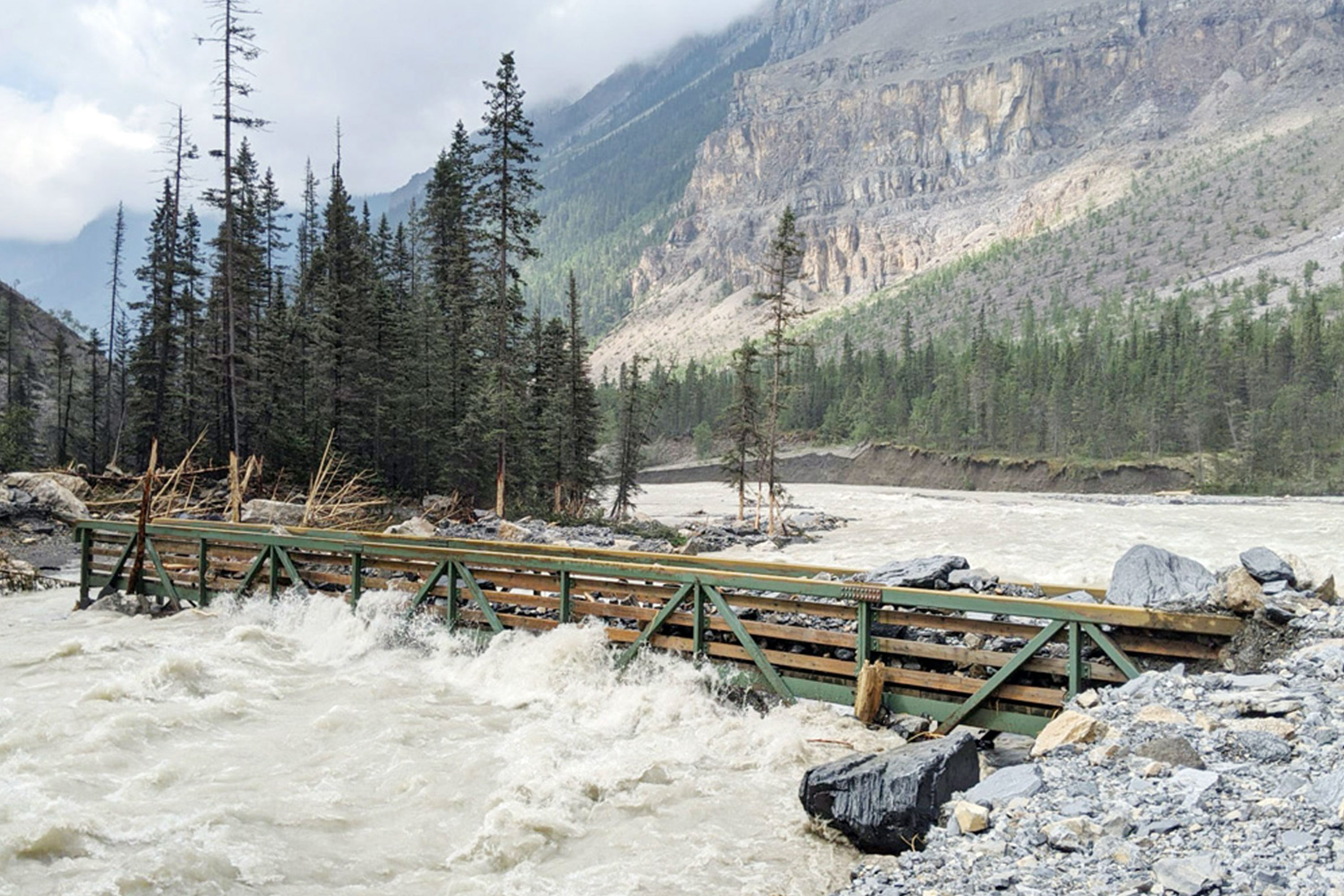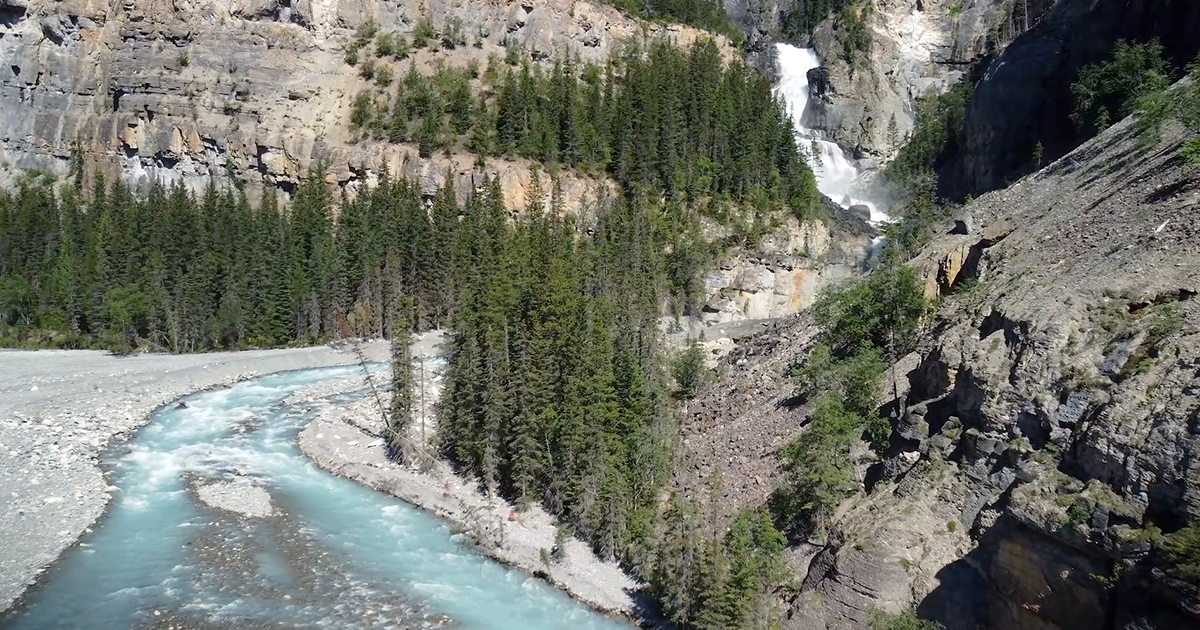TRAILBLAZING
In 2021, a brutal flood brought on by extreme heat destroyed much of the world-renowned Berg Lake Trail at Mount Robson Provincial Park in British Columbia.
It will take years to rebuild the trail, but industry leaders say the project could become a blueprint for parks across Canada looking to protect themselves from climate disasters.
As repairs begin, park managers are facing an existential question: How can parks balance tourism and sustainability?
Early on a golden morning in late August, a lone helicopter soars through the Valley of a Thousands Falls on Mount Robson’s rocky western flank. Ahead, a white cascade of water plunges over steep cliffs into the winding river thousands of metres below.
Looking through a rounded, bubble-like window, Mount Robson Provincial Park manager Elliott Ingles spots fragments of what was once a section of the Berg Lake Trail.
“Directly under us, you can see the trail’s just gone. The trail goes straight to the river and the flood washed out 500 metres of the trail,” said Ingles, speaking loudly into a headset over the helicopter’s steady thrum.
“There’s not really a way to rebuild it there.”

Entire chunks of the Berg Lake Trail are still missing, ripped away by a monstrous flood brought on by the heat dome that hung over British Columbia in 2021. Thousands of litres of water, shed by baking glaciers, roared down the mountain, tearing up the trail in the process.
Hundreds of long-weekend hikers were still on the trail as the water rose.

Mount Robson, the tallest peak in the Canadian Rockies and the centre of one of the oldest provincial parks in British Columbia, finds itself at a critical point in its history, staring down climate change.
BC Parks will restore the area, which will keep the Berg Lake Trail partially closed for two more years, while trying to answer a critical question: How exactly to rebuild against inevitable, unpredictable crises, while balancing the need for tourism and conservation?
Other parks in Canada are facing similar challenges, from eroding cliffs in Prince Edward Island National Park to wildfire-stricken forests in Alberta’s Jasper National Park. The answers found at Mount Robson could become a model that eventually helps preserve Canada’s parks for future generations.
BERG LAKE
Just about straddling the B.C.-Alberta border and looming nearly 2,900 metres above the valley below, Mount Robson is a mighty pyramid of dark, striped stone topped with glistening snowpacks.
The 42-kilometre trail leads tens of thousands of hikers up the mountain each year to Berg Lake, a turquoise pool fed by two glaciers on the north face.
The nearby Marmot Campground — one of seven campsites along the trail — is a place usually teeming with activity. Lately, it’s silent, aside from a braided river gurgling toward the lake.
Ingles, 40, has spent the better part of his life working in Canada’s parks, first in Jasper for 15 years and in Mount Robson for the last five.
At Berg Lake, he sees scars. The stunning glaciers, already with a finite lifespan, are noticeably smaller than when he took over management of the park a half-decade ago.
“The mountains are shifting.… That’s inevitable, but it seems faster and more frequent,” said Ingles.

Even at an elevation of 1,600 metres — halfway the distance to base camp on Mount Everest — temperatures at Berg Lake reached a punishing 37 C under the heat dome in June 2021.
“We were watching the glaciers. It looked like they were sweating,” Ingles recalled, squinting through the mid-morning sun.

Experts have said the intensity of last year’s heat wave, which brought days of record-breaking temperatures to much of B.C., would’ve been highly unlikely if not for climate change.
A 2018 report found extreme weather events will become more frequent and more intense if Canada continues warming at its current pace, increasing the likelihood of severe heat waves and flooding, as well as drought and wildfire risk.

“We are expecting to see, with the introduction of more greenhouse gases, further heat domes, further heat waves that will punish the glaciers that we have in [Mount] Robson Provincial Park, as it will many of the glaciers throughout the mountain regions of the planet,” said Brian Menounos, a University of Northern British Columbia professor and Hakai Institute affiliate who volunteers his time as a consultant for BC Parks.
“By 2050, things are really going to change.”
WHITEHORN
As he walks the surviving sections of the Berg Lake Trail, Ingles raises a hand, palm-down against his own frame, to indicate how high the water rose during the flood last year.
In some places, it’s to his knees. In others, it’s closer to his chest.
Standing on the rocky riverbank in the valley where the trail used to run past Whitehorn Campground, near famous milestones like Emperor Falls, Ingles’s hand rises to his waist.
Park staff watched as the Robson River rose menacingly under last year’s heat. By Canada Day, Ingles’s boss phoned to say water was already overwhelming bridges and they were going to close the trail.
Roughly 250 hikers were still up the mountain.
Over the next blistering 48 hours, Ingles slogged up and down the trail four times — the equivalent of running four full marathons up and down a mountain.
Parks staff, provincial firefighters, RCMP, search-and-rescue personnel and colleagues from Jasper National Park turned the Whitehorn area into a staging zone.
Hikers who were on the lower half of the trail, from Whitehorn Campground to the trailhead, walked themselves out through murky floodwater. More than 25 people — including a five-month-old baby — were airlifted out from higher points.

Nobody was hurt, but the trail was battered.
“The severity of it was nothing that we could have imagined,” Ingles said.
Currently, all that’s left of the trail near Whitehorn Campground is a ribbon of dusty earth tracing the river’s edge, before vanishing into the unsteady bank. The internationally recognized, widely Instagrammed Whitehorn suspension bridge stands decommissioned after 150 years.

Mount Robson reached record visitation in 2019, before the pandemic and the flood. More than 100,000 people came for day trips and another 40,000 camped overnight.
On average, hikers tackling the Berg Lake Trail bring roughly $2.4 million in revenue to Valemount, B.C., a growing village southwest of the mountain’s base — a recreation-centric community whose local brewery and coffee shop both have brews named for the peak.
“The trail use represented close to 20 per cent of our tourism,“ said Coun. Pete Pearson, chair of Tourism Valemount. “To have it lost for the next couple of years … it’s a big hit for us.”

Climate change can affect the length and quality of a tourism season, which has significant implications for visitation and, subsequently, revenue — both nationally and for small towns like Valemount, relying on park traffic for income.
Last year alone, Parks Canada drew more than $150 million in revenue nationwide.
KINNEY LAKE
For the rebuild, the Berg Lake Trail has been split roughly into thirds: one section from the trailhead up to Kinney Lake, a lower landmark usually feasible as a day trip for families.
The area from Kinney to Whitehorn Campground is section two, followed by the stretch from Whitehorn to Berg Lake.
The hope is to open lower parts of the trail first, while crews continue repairing upper areas.
The renovations will range from relocating vulnerable tent pads and rebuilding broken bridges, to reinforcing eroding riverbanks and elevating or rerouting wrecked trail sections.
There is no universal standard dictating when parks can officially be considered climate resilient. Even if there was, it would be a moving target.
“One way we might be able to tell if this park, or any other infrastructure, is resilient to climate is if the infrastructure itself starts to fall apart through normal wear and tear, and is not actually destroyed or affected by extreme events,” said Menounos.
“[But] climate resiliency will change depending on how we operate as humans.”
The team designing the trail is making decisions based on climate predictions, aerial surveys, 3D laser imaging known as LiDAR scanning, engineering principles, on-the-ground parks expertise and any number of additional factors — straining to find the best option for the least amount of money.
The Simpcw First Nation, Neskonlith Indian Band, Skw’lax First Nation, Lheidli T’enneh First Nation and Lhtako Dene Nation are all consulting on the second phase of the project, as the trail runs through their territories.
Even after decisions are made, mother nature could interfere. Any minor rockslide or shift in the river can — and will — send the team back to the drawing board, Ingles said.
The B.C. Ministry of Environment has budgeted $1.75 million for the first third of the rebuild, redirecting funding from other regional parks’ budgets to fund the project. The cost for the remaining two-thirds has yet to be determined, but a statement said the province will foot the entire bill since the project is not eligible for federal disaster funding.

The work ahead also carries an ethical dilemma: the trail will be rebuilt to survive climate change so tourists can continue visiting for generations, but travel, especially by air, contributes to the carbon dioxide emissions.
There’s also the “last-chance tourism” phenomenon: landmarks threatened by climate change can attract even more visitors motivated to see the site before it disappears.
The challenge for park managers, like Ingles, across the country running into rebuild scenarios will be finding balance between promoting tourism and ensuring sustainability.

Some experts believe the solution is to change the way Canada markets some of its best destinations: domestically, rather than internationally.
“If they come, they come. But don’t try to chase those [international] markets because those are the hardest ones to decarbonize,” said Daniel Scott, who leads the climate change program at the University of Waterloo.
Ingles has a theory: if people see Mount Robson and are moved by its beauty, as he has been, it’s possible they go home with renewed commitment to make sustainable change in their lives because they have a better understanding of the masterpieces at stake.
“There’s no way we’re going to stop people from wanting to explore. People have gone to crazy lengths to explore since the beginning of time,” he said, standing at the trailhead at dusk.
“Hopefully we can offset it, offset their experiences by educating them in the parks on what we can do to help climate change.… Hopefully, it’s an eye-opener for future generations to look at how we recreate.”
“There’s no way we’re going to stop people from wanting to explore. People have gone to crazy lengths to explore since the beginning of time.”





